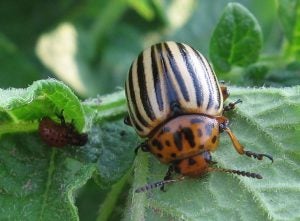Like most kids, I was smitten with dinosaurs — fantastic, borderline mythical beasts that reigned before recorded history. Though I had (mostly) grown out of that phase by 1993, the movie Jurassic Park reawakened a dino infatuation. Velociraptors were introduced as the baddies: predators that relentlessly pursued and savaged their prey. Tyrannosaurus Rex was the film’s climactic hero, the apex predator reclaiming its post-extinction throne.
Synonymous with power and calculated elegance, the name T. rex — literally tyrant lizard king — inspires fear and awe (even with its comically small nubs, and that it was probably more scavenger than bloodthirsty predator). Despite that, the cinematic legend had to be satisfied on screen. What better way to pay fanservice to T. rex enthusiasts?
Speaking of scientific names, here’s another epithet that should inspire dread and tempered awe: Leptinotarsa decemlineata.
The literal translation? Something along the lines of thin-footed beetle with 10 black stripes. Ok, not so intimidating.
Despite that, there’s a new king in town, and you can call his/her majesty the Colorado Potato Beetle (CPB). And here’s the kicker — we’ve put it on the throne.
Remember the stern warning from Dr. Ian Malcom (expertly played by Jeff Goldblum) that “life finds a way”? The CPB has found a way — to become resistant to every pesticide concoction we throw at it.
Not through careless gene jockeying in a lab, but a grander outdoor lab: farmer fields. No matter how responsible we are with pesticide use, the CPB always ends up outsmarting us.
Long before the reign of the dinosaurs, insects were (and still are) the consummate behind the scenes survivors. More cryptic and not as Hollywood “sexy” as dinosaurs, insects are the evolutionary innovators of our time.

When we hear evolution, we tend to think structural changes that give a species an advantage. But often, the most impactful design elements aren’t anatomical. How about minor biochemical tweaks — ones we can’t see with the naked eye?
Darwinian “survival of the fittest” is about outpacing the competition. Time for a hypothetical: If a spray rig comes through a field and kills 10,000 bugs, maybe 2 will survive — chance anomalies that could weather the pesticidal storm. They just happened to have the ability to detox, exclude, or contain the pesticide, and avoid harm. Those two become the founders of a super-strain population resistant to pesticide XYZ.
Now for a bombshell: Conventional wisdom has always held that random mutations were responsible for the CPB’s uncanny ability to develop resistance. These spot DNA changes introduced genetic diversity that resigned many to death, but a select few to thrive where pesticides were frequently applied.
Even though CPB’s do exhibit a very high degree of genetic variability, that alone doesn’t seem to fully explain their superhuman abilities. Recent research out of the University of Vermont suggests the CPB doesn’t necessarily have to change its genetic code, but merely flip certain gene switches on and off. Think of it as master control panel of on/off switches, with multiple configurations. This selective expression of genes is called DNA methylation (epigenetics). With the right on/off panel combo, defensive systems could be ramped up when confronted with a pesticide. And the kicker is that these changes appear to be passed between generations.
- Interestingly, this may be related to a suggested mechanism in Holocaust victims and their offspring. The trauma incurred by victims 75 years ago might reverberate to their ancestors — making them biochemically predisposed to anxiety disorders.
Whatever the mechanism of CPB resistance is, this is a potential gamechanger. Time to rewrite the books on Darwinian evolution? At least from the pesticide resistance angle? Perhaps.
Interestingly, this development gives some credence to the long-discredited idea of Lamarckian evolution. Jean-Baptiste Lamarck was an early evolutionist who proposed that traits acquired in life were passed to offspring. So logically, if a farmer lost fingers in a potato harvester accident, their kids would be fittingly fingerless. Obviously that’s not the case, but some life events do now appear to be biochemically (rather than physically) transmissible. Partial vindication nearly 200 years later.
Though we’re still processing the long-term implications of DNA methylation, it can help us strategize for the future. Resistance isn’t just biochemical, it can be behavioral too. Bait aversion is a frequent trait among many household pests. Even non-chemical management approaches aren’t sacred — they’re potentially vulnerable.
When it comes to the threat of resistance, continued diligence is key. My major qualm about pesticides has never been human health or environmental effects, but that farmers are directly responsible resistance stewards. Let’s eke out as much life from a pesticide as we can.
One take home is evident: We’ll need to ditch the exclusive fixation with pesticides and employ multiple approaches (enter Integrated Pest Management, or IPM) to keep these insect innovators on their Darwinian (Lamarckian?) toes. Risk diversification is key, just like any financial portfolio.
CPB, I must confess a grudging respect. So here’s to you: muncher of leaves, scoffer (atter?) of pesticides, purveyor of (farmer) ulcers, and tour de force of resistance, a tyrannical heavyweight in its own right.
Tim Durham’s family operates Deer Run Farm — a truck (vegetable) farm on Long Island, New York. As an agvocate, he counters heated rhetoric with sensible facts. Tim has a degree in plant medicine and is an Associate Professor at Ferrum College in Virginia.



